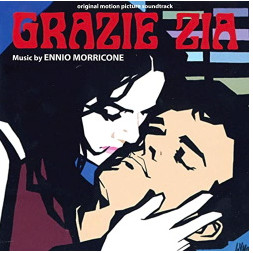主页--->m-comment-000--->mb-comment-005-54
|
电脑版 |
|||||||||||||||||
布罗克斯顿评说莫里康内 MB-005-54 |
||||||||||||||||||
FA6708 Grazie zia / Thank
You Aunt / 来和我一起玩 / 谢谢你阿姨 |
||||||||||||||||||
作者 乔纳森·布罗克斯顿 (Jonathan Broxton) |
||||||||||||||||||
ENNIO MORRICONE 评论,第5部分 005-54 |
||||||||||||||||||
 |
||||||||||||||||||
谢谢你阿姨 (1968) Grazie Zia,英文名 Come Play With Me,是一部由 Salvatore Samperi 执导的黑暗剧情片。这部电影由卢·卡斯特尔 (Lou Castel) 饰演阿尔维斯 (Alvise),一个可能瘫痪也可能不瘫痪的年轻人,正在接受心理问题的治疗。当阿尔维斯被他的姨妈莉亚(丽莎·加斯托尼饰)照顾了几天时,他很快就迷恋上了她; 当莉亚出人意料地回报他的进步时,两人开始了一场基于游戏、输赢的激烈恋情——这些赌注最终涉及真正的生死。 莫里康内的配乐基于几个反复出现的主题,这些主题在电影和配乐中被多次重演。五首曲子中最著名的是“Guerra E Pace, Pollo E Brace”,这是一首非常不寻常的节奏曲,由Renata Cortiglioni的男声合唱团表演,具有凶猛的摇滚爵士鼓点和奇怪的吟唱合唱声;它有一种时髦、催眠、异国情调的氛围,很难描述,但却是典型的莫里康内。 标题主题“Grazie Zia”是一首梦幻般的作品,由抽象的大键琴音符、拨弦、叮叮当当的金属打击乐以及男孩合唱团的更多人声组成,这些人声淡入淡出,营造出一种奇特的、令人迷失方向的氛围。随着提示的进行,它出现在更活泼的旋律中,出现更刺耳的吉他和类似民谣的增强,然后回归到大键琴和打击乐的鲜明、不和谐的写作,听起来非常令人不安,就像一个破碎的音乐盒。后来,“Amore Col Cuore”和“La Guerra, La Pace”都以温柔和脆弱的方式推断了音乐盒的想法,但前者用教堂管风琴和钢琴和弦的沉闷而气势磅礴的缓慢进行曲抵消了这一点,这听起来像是他为 1974 年电影 Allonsanfàn 中的著名进行曲“Rabbia e Tarantella”进行的试唱。 多年来,Grazie Zia 的配乐已多次发行,包括 CD 和 LP,以及作为众多 Morricone 合辑的组曲。最全面的版本似乎是 2013 年发行的 Digitmovies 发行的 CD,其中包含“Guerra e Pace, Pollo e Brace”主曲目的几个版本,以及莫里康内与作词家奥黛丽·斯坦顿·诺赫拉合作创作的一些原创歌曲。 曲目列表: 1. Guerra e Pace, Pollo e Brace (2:27), 2.弗拉泰罗·比昂多 (2:49), 3.Grazie Zia (4:29), 4.Guerra e Pace, Pollo e Brace (Marcetta) (1:43), 5.爱茉莉·科尔·库尔 (2:28), 6.Filastrocca Vietnamita (由Sergio Endrigo演唱) (3:21), 7.拉格拉,拉佩斯 (1:02), 8.Guerra e Pace, Pollo e Brace (Marcetta #2) (1:39), 9.弗拉泰罗·比昂多 #2 (2:17), 10.爱茉莉·科尔·库雷 #2 (3:00), 11.Guerra e Pace, Pollo e Brace (Marcetta #3) (3:43), 12.Grazie Zia #2 (4:38), 13.La Guerra,La Pace #2 (2:07),14。Guerra e Pace, Pollo e Brace #2 (4:04).Digitmovies CDDM-227,39 分 47 秒。 |
||||||||||||||||||
2020.8.2 |
||||||||||||||||||
|
| ||||||||||||||||||
以下是原文
| ||||||||||||||||||
ENNIO MORRICONE REVIEWS, Part 5-54 |
||||||||||||||||||
GRAZIE ZIA (1968) Grazie Zia, known as Come Play With Me in English, is a dark drama film directed by Salvatore Samperi. The film stars Lou Castel as Alvise, a young man who may or may not be paralyzed, and is receiving treatment for psychological problems. When Alvise is left in the care his aunt Lea (Lisa Gastoni) for a few days, he quickly becomes infatuated with her; when Lea unexpectedly reciprocates his advances, the two begin a torrid affair based around the playing, winning and losing of games – the stakes for which ultimately involve literal life and death. Morricone’s score is based around several recurring themes which are reprised numerous times over the course of the film and the soundtrack. The most famous of the five is “Guerra E Pace, Pollo E Brace,” a highly unusual rhythmic piece for a ferocious, rock-jazz drumbeat and oddly-pitched chanted choral vocals performed by the Boys’ Choir of Renata Cortiglioni; it’s got a groovy, hypnotic, exotic vibe that is difficult to describe but is quintessentially Morricone. The title theme, “Grazie Zia,” is a dream-like piece for abstract harpsichord notes, plucked strings, tinkling metallic percussion, and more vocals from the Boys Choir that fade in and out of the piece to create a peculiar, disorienting atmosphere. As the cue progresses it emerges into a livelier melody for more strident guitars and folk-like augmentations, then regresses back to stark, dissonant writing for harpsichord and percussion that sounds quite disturbing, like a broken music box. Later, both “Amore Col Cuore” and “La Guerra, La Pace” extrapolate on the music box ideas with gentleness and fragility, but the former offsets this with a dour and imposing slow march for church organ and piano chords in what sounds like a dry run for his famous march “Rabbia e Tarantella” from the 1974 film Allonsanfàn. The score for Grazie Zia has been released many times over the years, on CD and LP, and as a suite on numerous Morricone compilations. The most comprehensive version appears to be the CD release from Digitmovies released in 2013, which contains several versions of the main “Guerra e Pace, Pollo e Brace” track, plus a number of original songs written by Morricone in collaboration with lyricist Audrey Stainton Nohra. Track Listing: 1. Guerra e Pace, Pollo e Brace (2:27), 2. Fratello Biondo (2:49), 3. Grazie Zia (4:29), 4. Guerra e Pace, Pollo e Brace (Marcetta) (1:43), 5. Amore Col Cuore (2:28), 6. Filastrocca Vietnamita (performed by Sergio Endrigo) (3:21), 7. La Guerra, La Pace (1:02), 8. Guerra e Pace, Pollo e Brace (Marcetta #2) (1:39), 9. Fratello Biondo #2 (2:17), 10. Amore Col Cuore #2 (3:00), 11. Guerra e Pace, Pollo e Brace (Marcetta #3) (3:43), 12. Grazie Zia #2 (4:38), 13. La Guerra, La Pace #2 (2:07), 14. Guerra e Pace, Pollo e Brace #2 (4:04). Digitmovies CDDM-227, 39 minutes 47 seconds. |
||||||||||||||||||
Aug 2, 2020 |
||||||||||||||||||
本站电影欣赏 |
||||||||||||||||||
在线音乐试听 |
||||||||||||||||||
 |
||||||||||||||||||
Jon 是一位电影音乐评论家和记者,自 1997 年以来一直担任全球最受欢迎的英语电影音乐网站之一 Movie Music UK 的编辑和首席评论员,并且是国际电影音乐评论家协会 (IFMCA) 的主席。在过去的 20多 年中,Jon 撰写了 3,000 多篇评论和文章,并进行了多次作曲家采访。在杂志刊物方面,乔恩曾为《电影配乐月刊》、《原声带杂志》和《电影音乐》等出版物撰写评论和文章,并为普罗米修斯唱片公司的两张经典 Basil Poledouris 配乐专辑《Amanda》和《Flyers / Fire on the Mountain》撰写了衬垫注释。他还为汤姆·胡佛 (Tom Hoover) 于 2011 年出版的《Soundtrack Nation: Interviews with Today's Top Professionals in Film, Videogame, and Television Scorering》一书撰写了一章。在1990年代后期,乔恩是伦敦皇家爱乐乐团的电影音乐顾问,并与他们合作拍摄了约翰·德布尼(John Debney)的音乐电影《相对价值》(Relative Values)和奥利弗·海斯(Oliver Heise)的音乐《佛陀的指环》(The Ring of the Buddha),以及与兰迪·纽曼(Randy Newman)合作的一系列音乐会。2012年,乔恩在波兰克拉科夫举行的第五届年度电影音乐节上担任“电影节学院”主席。他是作曲家和作词家协会的成员,该协会是作曲家、作词家和词曲作者从事电影、电视和多媒体工作的首要非营利组织。 |
||||||||||||||||||
2023.11.28 |
||||||||||||||||||
2023 手机版 |
||||||||||||||||||
|
||||||||||||||||||













